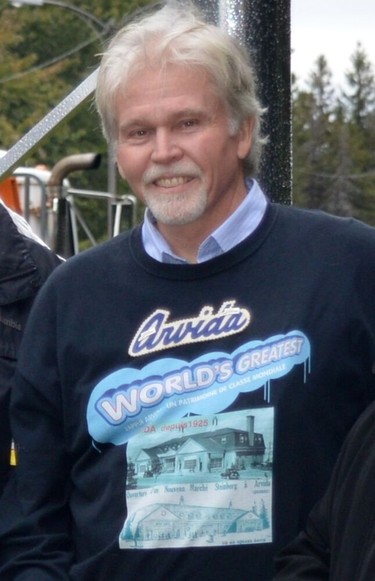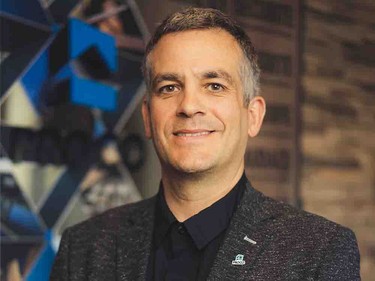The historic aluminum town of Saugenay, Que., is on the front lines of the trade war, but unemployment is low and industry is thriving. All it needs to launch a new golden age is more people
Article content
Among the perks retired flight director Terry Loucks has for working at Air Canada for 25 years is that he can fly anywhere, including Paris, for about $100 round trip. But Paris, while undeniably “nice,” is not uppermost in his mind most days, given his travel plans are often attached to his hometown of Arvida, which was incorporated into the city of Saguenay, Que., two decades ago and requires a tank of gas and seven hours of driving from the 77-year-old’s current home near the Vermont border.
Advertisement 2
Article content
Loucks has not lived in northern Quebec for some time, but the locals view him as somewhat of a local treasure because of all the work he has done to promote the history of a place that started as a farmer’s field in the “middle of nowhere” 250 kilometres north of Quebec City.
Article content
Article content

Article content
That changed when Arthur Vining Davis, a wealthy American industrialist/aluminum magnate, showed up a century ago with an offer to buy the farm and several others nearby so that he could build an industrial paradise by producing aluminum to feed a growing appetite for a versatile metal found in everything from cookware to the engine block of the Wright brothers’ aircraft.
“Arvida began as a unique industrial utopia; it was unheard of anywhere else in the world,” Loucks said.
Davis, however, was better known and soon became chair of Aluminum Co. of America, a.k.a. Alcoa Corp. The town he built from scratch attracted engineers from around the world and, as per its founder’s vision, the houses were all of a similar size and laid out in such a way that there was no rich versus poor end of town, nor any great antagonism between French and English, nor any other of the 30-plus nationalities who came to make a go of it there.
Article content

In other words, those slugging it out in what would become the world’s largest aluminum plant rubbed shoulders with the higher-ups, occasionally in the house next door. The former company town today has provincial heritage status and it is credited with producing the aluminum used to build the bombers and fighter planes that helped the Allies win the Second World War.
Article content
“It is important to know where you came from to know where you are going to next,” Loucks said.
It is important to know where you came from to know where you are going to next
Terry Loucks
Where the aluminum centre is now is in the midst of another war, though the modern-day adversary is the 50 per cent tariffs United States President Donald Trump’s administration has applied to a metal that remains central to Saguenay’s economic well-being: 12,000 people, out of a working population of 75,000 or so, are either directly employed in aluminum production or indirectly employed through tertiary and spinoff industries.
But in the face of the Trump-triggered trade tumult, local thinkers, business leaders, politicians and at least one heritage-loving champion believe the predominantly French-speaking city is poised to enter a new golden age, fortified by an attitude towards the U.S. president that could be translated into English as “Bring it on.”
Granted, it may simply be the way folks are wired in northern Quebec, but Saguenay’s economic indicators are holding up well compared to some tariff-battered areas, such as auto-making hub Windsor, Ont., a border city that has experienced recent layoffs and is flirting with a 10 per cent unemployment rate.
The national unemployment is 6.9 per cent, but it’s just 4.3 per cent in Davis’s utopia, as it has been for months, and locals are keen to get the word out.
Article content
“I want to position Saguenay as Canada’s great metropolis of the northeast because the fact is we have everything here,” Mayor Luc Boivin said.
The “everything” he’s referring to, in addition to low unemployment, includes about three feet of snow by mid-November that nobody seemed to be grumbling about. Winter weather means snowmobiling, skiing and ice fishing, and its early arrival highlights the benefits of living in a place where traffic jams are unheard of and people’s vacation homes are 30 minutes (or less) from their front door.

There are other attractions, too, Boivin said, ticking through a list of Saguenay’s economic assets: a university, a research centre for aluminum and technology development, the presence of a big, multinational company in aluminum and mining called Rio Tinto Group of Cos., a large military base, original equipment manufacturers, construction businesses, tech startups, mining plays, power dams, a deep-water port connecting to global markets and a collective community vision to someday create a “northern corridor” that links resource-rich northern Ontario with resource-rich northern Quebec. Just in case that is not enough, there is a 100-kilometre-long fjord designated as a national park.
Article content
Boivin is 50 years old, has boundless energy and is representative of Saguenay’s can-do spirit. There is more to aluminum country than the versatile metal, and his family’s story is proof of that. His grandparents started a cheese-making business in 1939 and he worked there for 35 years prior to selling his share in the company to commit full time to building the great metropolis of the northeast.
On that note, Rio Tinto remains a cornerstone. The company has announced $4 billion in new projects in the region since 2020, including massive upgrades to its hydroelectric plant and a new aluminum recycling plant, as well as pouring hundreds of millions of dollars into developing commercial-quality, low-carbon-emission aluminum.
Trump’s tariffs cost Rio Tinto about US$321 million in gross costs through the first six months of 2025, according to a company spokesperson, and it has instituted a local hiring freeze, but the negative hits have been partially offset by high aluminum prices and a pivot to overseas export markets.
Quebec’s abundant resources, skilled workforce and commitment to sustainable development make it a “natural fit for Rio Tinto’s long-term ambitions,” the spokesperson said.
Article content
Article content

Another factor in the area’s success is its proximity to the U.S., which produces about 670,000 tons of aluminum, about 4.5 million tons less than it needs. Canadian aluminum makes up the bulk of this shortfall and a significant chunk of it is derived from Rio Tinto’s five smelters in the Saguenay-Lac-Saint-Jean region.
“The Americans have to import aluminum,” Jean Simard, chief executive of the Aluminum Association of Canada, said.
In short, Rio Tinto can pivot to overseas markets in a pinch, but American aluminum appetites ultimately still need to be fed. Pre-tariff stockpiles south of the border have been exhausted and the 50 per cent tariff on foreign aluminum has been priced into the market, so the north-south trade has more or less reverted back to the norm, Simard said; only the cost of doing business is now exponentially more expensive.
We have everything, but we need more young people to move here
Luc Boivin
In Saguenay, meanwhile, Rio Tinto’s buy-local philosophy is keeping local contractors busy beavering away at projects, at least for now, and afforded Boivin time to tackle what he and others perceive as the city’s greatest existential threat: demographics.
“We have everything, but we need more young people to move here,” he said.
Sophie Villeneuve and her husband, Maxime Couture, can’t pass for young anymore, but they are certainly youngish and have two young kids. The couple are in the vanguard of what they hope will be a northern migration of professionals to a place that may not have the same abundance of restaurants as, say, Montreal, but the local sushi joint — and there is only one — rivals anything one might find down south. It helps that the family loves to ski and that Villeneuve grew up in Arvida as a daughter of an aluminum industry worker.
Article content

She left home in the early 2000s during what locals refer to as the “yellow school bus” era, so named since it seemed as though another school bus full of young people was leaving town every week and never looking back.
Case in point: Villeneuve. She moved to Ottawa to work for a member of Parliament and later met Couture, who also worked in politics. They eventually opened their own strategic communications company in Quebec City before relocating to Saguenay four years ago.
“There were a lot of pros and not a lot of cons,” Couture said, “so we just decided to try it.”
He admits that finding a flight out of Saguenay-Bagotville Airport to New York or Paris can be a bit tricky, but apart from trip-planning logistics, there have been no regrets. The unforeseen bonus is their company, Catapulte Communication, which specializes in government relations, or lobbying, and has clients in Canada, the U.S. and France, has experienced 20 per cent year-over-year growth and is showing no signs of slowing down.
“The mood here when I first finished university was not good, but that has changed,” Villeneuve said.
Part of the change is rooted in diversification. Distances are not as great as they were once upon a time, when being 250 kilometres north of Quebec City meant being a long way from anywhere. Several locals shared the same belief that Saguenay’s historic remoteness fostered a pioneering culture of entrepreneurship that still exists. For example, if a gadget at the local smelter broke back in the day, having the know-how to fix it without having to call in help from afar was critical.
Article content
That do-it-ourselves attitude is reflected by some of aluminum country’s most notable human exports. Serge Godin, the billionaire founder of IT consulting giant CGI Inc., and Alain Bouchard, the billionaire founder of convenience store chain Alimentation Couche-Tard Inc., are both former locals who made it big. Georges Vézina, the Montreal Canadiens legend known as the “Chicoutimi Cucumber” due to his cool demeanour when under fire in the net, also came from the area and returned to die there of tuberculosis in the 1920s.
Somewhat less legendary is Jeannot Harvey, who carved a niche that became a small construction and civil engineering empire called Cegerco Inc. through its work on major hydroelectric projects.

His daughter, Eloise, did not want to take over when he decided to retire since she was too busy carving out her own entrepreneurial path with Epiq Machinery, a global, heavy industrial material handling company. Epiq manufactures big, often specialized equipment for factories and has 1,000 employees worldwide, including 500 in India’s auto alley and 180 at three fabrication facilities in Saguenay.
“When you have a very strong industrial sector, such as the primary aluminum producers, it creates a certain stability in an area,” she said. “I don’t know if it’s the right expression, but it is the economic tissue and it connects an entire ecosystem, where aluminum is the motor of the economy and all sorts of parts are able to spin off from that motor.”
Article content
Seventy per cent of Epiq’s sales derive from aluminum-related industries, underscoring the importance of keeping that motor running. The younger Harvey, not unlike Villeneuve, imagined her future outside Saguenay and went “abroad” for university. As the crow flies from northern Quebec, “abroad” meant McMaster University in Hamilton, where she studied engineering and management.
“I wanted to live the full experience; I wanted to learn English,” she said.
At the end of a busy workweek, it can be a bit challenging to find the right English words to express herself, Harvey said, but she is unequivocal in saying her biggest concern looking ahead to 2026 is the ongoing “uncertainty.”
Trump is still here, the trade war drags on and the billions in new projects and investments that Rio Tinto has committed to Saguenay and helped maintain the overall health of the “ecosystem” will theoretically run out at some point, and then what?

It is a good question, and Jean-Denis Toupin, another second-generation Saguenay entrepreneur, layers an additional concern on top of it. Proco Construction Inc., his steel fabrication and construction company, employs about 450 people and annually generates $150 million in revenues.
Article content
He sources steel from Spain and he gets the skilled-trades workers required to weld it together from wherever he can find them since there are not enough Canadian welders to go around. Sixty of his crew are temporary foreign workers. Without them, he said he would not be able to fill his job orders.
But bringing in workers has become more difficult since the federal government pledged to reduce the number of permits issued annually to try to mitigate the national housing crisis, while the Conservatives have called upon the government to scrap the temporary foreign worker program altogether.
“We are already down 17 welders,” Toupin said. “I’ve spent the last year and a half speaking to government representatives at all levels about this problem and no one wants to hear about it because it is not politically popular. Economic workers get lumped in with other immigrants in the public mind, and the public feels immigration numbers are too high.”
Toupin is no fan of Trump, but his most pressing headache is remaining competitive in his own backyard. There are lots of projects to bid on and not every one of them is related to Rio Tinto. There is a whole gamut of opportunities in mining, rail and the port, but without the bodies to get whatever the jobs are done, he risks losing out.
Article content
“It is the same reality for dozens of other companies here involved in industrial projects; we have very low population growth,” he said.
What the locals do have is jobs. Unemployment is low and the industrial motor keeps chugging along, indicating that there is a future and it is connected to the past. Loucks, the Arvida cheerleader, in early December will be gassing up his blue compact car and shoving off for Saguenay to attend a planning meeting at a local theatre in advance of Arvida’s centennial celebration.
The industrial utopia that began as a farmer’s field endures, and the chatter out of Prime Minister Mark Carney’s office concerning grand nation-building projects, fast-tracking approval processes, tapping into the country’s natural resources wealth and growing trade relationships overseas has folks in northern Quebec envisioning a new golden age, that is, if enough young people can be convinced to move there to bring it to life.
“The drive north can be a little treacherous,” Loucks said, “but once you have arrived, it is a special place to be.”
• Email: [email protected]
Article content








